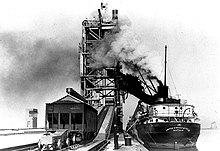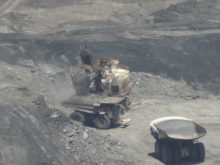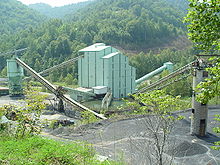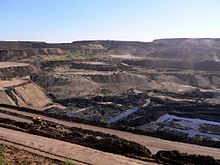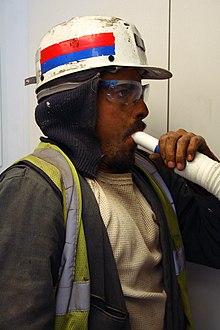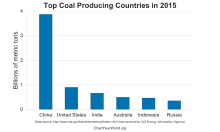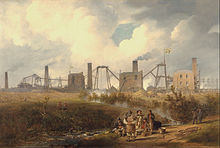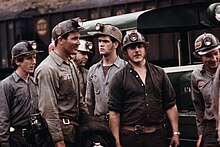Balmain Coal Mine in New South Wales in 1950. Photograph taken by Sam Hood for LJ Hooker, State Library of New South Wales, 31753
Coal miners leaving an American mine at the end of a shift (April 1974)
Surface coal mining in Wyoming in the United States.
A coal mine in Bihar, India.
A coal mine in Frameries, Belgium
Coal mining is the process of extracting coal from the ground. Coal is valued for its energy content, and, since the 1880s, has been widely used to generate electricity. Steel and cement industries use coal as a fuel for extraction of iron from iron ore and for cement production. In the United Kingdom and South Africa, a coal mine and its structures are a colliery, a coal mine a pit, and the above-ground structures the pit head. In Australia, "colliery" generally refers to an underground coal mine. In the United States, "colliery" has been used to describe a coal mine operation but nowadays the word is not commonly used.
Coal mining has had many developments over the recent years, from
the early days of men tunneling, digging and manually extracting the
coal on carts, to large open cut and long wall mines. Mining at this scale requires the use of draglines, trucks, conveyors, hydraulic jacks and shearers.
History
Ships have been used to haul coal since Roman times.
Small-scale mining of surface deposits dates back thousands of years. For example, in Roman Britain, the Romans were exploiting most of the major coalfields by the late 2nd century AD.
The Industrial Revolution,
which began in Britain in the 18th century and later spread to
continental Europe and North America, was based on the availability of
coal to power steam engines. International trade expanded rapidly when coal-fed steam engines were built for the railways and steamships.
Until the late nineteenth century coal was mined underground
using a pick and shovel, and children were often employed underground in
dangerous conditions. Coal-cutting machines were introduced in the 1880s. By 1912, surface mining was conducted with steam shovels designed for coal mining.
Methods of extraction
The most economical method of coal extraction from coal seams depends on the depth and quality of the seams, and the geology
and environmental factors. Coal mining processes are differentiated by
whether they operate on the surface or underground. Many coals extracted
from both surface and underground mines require washing in a coal preparation plant. Technical and economic feasibility are evaluated based on the following: regional geological conditions; overburden
characteristics; coal seam continuity, thickness, structure, quality,
and depth; strength of materials above and below the seam for roof and
floor conditions; topography (especially altitude and slope); climate;
land ownership as it affects the availability of land for mining and
access; surface drainage patterns; ground water conditions; availability
of labor and materials; coal purchaser requirements in terms of
tonnage, quality, and destination; and capital investment requirements.
Surface mining and deep underground mining are the two basic
methods of mining. The choice of mining method depends primarily on
depth, density, overburden and thickness of the coal seam; seams
relatively close to the surface, at depths less than approximately
180 ft (55 m), are usually surface mined.
Coal that occurs at depths of 180 to 300 ft (55 to 90 m) are
usually deep mined, but in some cases surface mining techniques can be
used. For example, some western U.S. coal that occur at depths in excess
of 200 ft (60 m) are mined by the open pit methods, due to thickness of
the seam 60–90 feet (20–25 metres). Coals occurring below 300 ft (90 m)
are usually deep mined.
However, there are open pit mining operations working on coal seams up
to 1,000–1,500 feet (300–460 metres) below ground level, for instance Tagebau Hambach in Germany.
Surface mining
When coal seams are near the surface, it may be economical to extract the coal using open cut
(also referred to as open cast, open pit, mountaintop removal or strip)
mining methods. Open cast coal mining recovers a greater proportion of
the coal deposit than underground methods, as more of the coal seams in
the strata
may be exploited. This equipment can include the following: Drag lines
which operate by removing the overburden, power shovels, large trucks in
which transport overburden and coal, bucket wheel excavators, and
conveyors. In this mining method, explosives are first used in order to
break through the surface or overburden, of the mining area. The
overburden is then removed by draglines or by shovel and truck. Once the
coal seam is exposed, it is drilled, fractured and thoroughly mined in
strips. The coal is then loaded onto large trucks or conveyors for
transport to either the coal preparation plant or directly to where it
will be used.
Most open cast mines in the United States extract bituminous coal. In Canada (BC), Australia and South Africa, open cast mining is used for both thermal and metallurgical coals. In New South Wales open casting for steam coal and anthracite
is practiced. Surface mining accounts for around 80 percent of
production in Australia, while in the US it is used for about 67 percent
of production. Globally, about 40 percent of coal production involves
surface mining.
Strip mining
Strip
mining exposes coal by removing earth above each coal seam. This earth
is referred to as overburden and is removed in long strips. The
overburden from the first strip is deposited in an area outside the
planned mining area and referred to as out-of-pit dumping. Overburden
from subsequent strips are deposited in the void left from mining the
coal and overburden from the previous strip. This is referred to as
in-pit dumping.
It is often necessary to fragment the overburden by use of
explosives. This is accomplished by drilling holes into the overburden,
filling the holes with explosives, and detonating the explosive. The
overburden is then removed, using large earth-moving equipment, such as drag lines, shovel and trucks, excavator and trucks, or bucket-wheels
and conveyors. This overburden is put into the previously mined (and
now empty) strip. When all the overburden is removed, the
underlying coal seam will be exposed (a 'block' of coal). This block of
coal may be drilled and blasted (if hard) or otherwise loaded onto
trucks or conveyors for transport to the coal preparation (or wash)
plant. Once this strip is empty of coal, the process is repeated with a
new strip being created next to it. This method is most suitable for
areas with flat terrain.
Equipment to be used depends on geological conditions. For
example, to remove overburden that is loose or unconsolidated, a bucket
wheel excavator might be the most productive. The life of some area
mines may be more than 50 years.
Contour mining
The
contour mining method consists of removing overburden from the seam in a
pattern following the contours along a ridge or around the hillside.
This method is most commonly used in areas with rolling to steep
terrain. It was once common to deposit the spoil on the downslope side
of the bench thus created, but this method of spoil disposal consumed
much additional land and created severe landslide and erosion problems.
To alleviate these problems, a variety of methods were devised to use
freshly cut overburden to refill mined-out areas. These haul-back or
lateral movement methods generally consist of an initial cut with the
spoil deposited down slope or at some other site and spoil from the
second cut refilling the first. A ridge of undisturbed natural material
15 to 20 ft (5 to 6 m) wide is often intentionally left at the outer
edge of the mined area. This barrier adds stability to the reclaimed
slope by preventing spoil from slumping or sliding downhill.
The limitations of contour strip mining are both economic and
technical. When the operation reaches a predetermined stripping ratio
(tons of overburden/tons of coal), it is not profitable to continue.
Depending on the equipment available, it may not be technically feasible
to exceed a certain height of high wall. At this point, it is possible
to produce more coal with the augering method in which spiral drills
bore tunnels into a high wall laterally from the bench to extract coal
without removing the overburden.
Mountaintop removal mining
Mountaintop coal mining is a surface mining practice involving
removal of mountaintops to expose coal seams, and disposing of
associated mining overburden in adjacent "valley fills." Valley fills
occur in steep terrain where there are limited disposal alternatives.
Mountaintop removal
combines area and contour strip mining methods. In areas with rolling
or steep terrain with a coal seam occurring near the top of a ridge or
hill, the entire top is removed in a series of parallel cuts. Overburden
is
deposited in nearby valleys and hollows. This method usually leaves
ridge and hill tops as flattened plateaus. The process is highly controversial for the drastic changes in topography, the practice of
creating head-of-hollow-fills, or filling in valleys with mining debris, and for covering streams and disrupting ecosystems.
Spoil is placed at the head of a narrow, steep-sided valley or
hollow. In preparation for filling this area, vegetation and soil are
removed and a rock drain constructed down the middle of the area to be
filled, where a natural drainage course previously existed. When the
fill is completed, this under drain will form a continuous water runoff
system from the upper end of the valley to the lower end of the fill.
Typical head-of-hollow fills are graded and terraced to create
permanently stable slopes.
Underground mining
Coal wash plant in Clay County, Kentucky
Most coal seams are too deep underground for opencast mining and
require underground mining, a method that currently accounts for about
60 percent of world coal production. In deep mining, the room and pillar or bord and pillar
method progresses along the seam, while pillars and timber are left
standing to support the mine roof. Once room and pillar mines have been
developed to a stopping point (limited by geology, ventilation, or
economics), a supplementary version of room and pillar mining, termed
second mining or retreat mining,
is commonly started. Miners remove the coal in the pillars, thereby
recovering as much coal from the coal seam as possible. A work area
involved in pillar extraction is called a pillar section.
Modern pillar sections use remote-controlled equipment, including
large hydraulic mobile roof-supports, which can prevent cave-ins until
the miners and their equipment have left a work area. The mobile roof
supports are similar to a large dining-room table, but with hydraulic
jacks for legs. After the large pillars of coal have been mined away,
the mobile roof support's legs shorten and it is withdrawn to a safe
area. The mine roof typically collapses once the mobile roof supports
leave an area.
Remote Joy HM21 Continuous Miner used underground
There are six principal methods of underground mining:
- Longwall mining accounts for about 50 percent of underground production. The longwall shearer has a face of 1,000 feet (300 m) or more. It is a sophisticated machine with a rotating drum that moves mechanically back and forth across a wide coal seam. The loosened coal falls onto an armored chain conveyor or pan line that takes the coal to the conveyor belt for removal from the work area. Longwall systems have their own hydraulic roof supports which advance with the machine as mining progresses. As the longwall mining equipment moves forward, overlying rock that is no longer supported by coal is allowed to fall behind the operation in a controlled manner. The supports make possible high levels of production and safety. Sensors detect how much coal remains in the seam while robotic controls enhance efficiency. Longwall systems allow a 60-to-100 percent coal recovery rate when surrounding geology allows their use. Once the coal is removed, usually 75 percent of the section, the roof is allowed to collapse in a safe manner.
- Continuous mining utilizes a Continuous Miner Machine with a large rotating steel drum equipped with tungsten carbide picks that scrape coal from the seam. Operating in a "room and pillar" (also known as "bord and pillar") system—where the mine is divided into a series of 20-to-30-foot (5–10 m) "rooms" or work areas cut into the coalbed—it can mine as much as 14 tons of coal a minute, more than a non-mechanised mine of the 1920s would produce in an entire day. Continuous miners account for about 45 percent of underground coal production. Conveyors transport the removed coal from the seam. Remote-controlled continuous miners are used to work in a variety of difficult seams and conditions, and robotic versions controlled by computers are becoming increasingly common. Continuous mining is a misnomer, as room and pillar coal mining is very cyclical. In the US, one can generally cut 20 feet (6 meters) (or a bit more with MSHA permission) (12 meters or roughly 40 ft in South Africa before the Continuous Miner goes out and the roof is supported by the Roof Bolter), after which, the face has to be serviced, before it can be advanced again. During servicing, the "continuous" miner moves to another face. Some continuous miners can bolt and rock dust the face (two major components of servicing) while cutting coal, while a trained crew may be able to advance ventilation, to truly earn the "continuous" label. However, very few mines are able to achieve it. Most continuous mining machines in use in the US lack the ability to bolt and dust. This may partly be because incorporation of bolting makes the machines wider, and therefore, less maneuverable.
- Room and pillar mining consists of coal deposits that are mined by cutting a network of rooms into the coal seam. Pillars of coal are left behind in order to keep up the roof. The pillars can make up to forty percent of the total coal in the seam, however where there was space to leave head and floor coal there is evidence from recent open cast excavations that 18th-century operators used a variety of room and pillar techniques to remove 92 percent of the in situ coal. However, this can be extracted at a later stage.
- Blast mining or conventional mining, is an older practice that uses explosives such as dynamite to break up the coal seam, after which the coal is gathered and loaded onto shuttle cars or conveyors for removal to a central loading area. This process consists of a series of operations that begins with “cutting” the coalbed so it will break easily when blasted with explosives. This type of mining accounts for less than 5 percent of total underground production in the US today.
- Shortwall mining, a method currently accounting for less than 1 percent of deep coal production, involves the use of a continuous mining machine with movable roof supports, similar to longwall. The continuous miner shears coal panels 150 to 200 feet (45 to 60 metres) wide and more than a half-mile (1 km) long, having regard to factors such as geological strata.
- Retreat mining is a method in which the pillars or coal ribs used to hold up the mine roof are extracted; allowing the mine roof to collapse as the mining works back towards the entrance. This is one of the most dangerous forms of mining, owing to imperfect predictability of when the roof will collapse and possibly crush or trap workers in the mine.
Production
Coal production trends 1980-2012 in the top five coal-producing countries (US EIA)
Coal mine in China
Coal mine in Australia
Coal is mined commercially in over 50 countries. Over 7,036 Mt/yr of hard coal was produced in 2007, a substantial increase over the previous 25 years. In 2006, the world production of brown coal
(lignite) was slightly over 1,000 Mt, with Germany the world's largest
brown coal producer at 194.4 Mt, and China second at 100.6 Mt.
Coal production has grown fastest in Asia, while Europe has
declined. Since 2013, the world coal production is decreasing, -6% in
2016. The top coal mining nations are:
| Country | Production |
|---|---|
| China | 3,450 Mt |
| United States | 973 Mt |
| India | 557 Mt |
| Australia | 409 Mt |
| Russia | 298 Mt |
| Indonesia | 252 Mt |
| South Africa | 250 Mt |
| Poland | 135 Mt |
| Kazakhstan | 101 Mt |
| Colombia | 75 Mt |
Most coal production is used in the country of origin, with around 16 percent of hard coal production being exported.
Coal reserves
are available in almost every country worldwide, with recoverable
reserves in around 70 countries. At current production levels, proven coal reserves are estimated to last 147
years. However, production levels are by no means level, and are in fact increasing and some estimates are that peak coal could arrive in many countries such as China and America by around 2030. Coal reserves are usually stated as
either (1) "Resources" ("measured" + "indicated" + "inferred" =
"resources", and then, a smaller number, often only 10-20% of
"resources", (2) "Run of Mine" (ROM) reserves, and finally (3)
"marketable reserves", which may be only 60% of ROM reserves. The standards for reserves are set by stock exchanges, in consultation with industry associations. For example, in ASEAN countries reserves standards follow the Australasian Joint Ore Reserves Committee Code (JORC) used by the Australian Securities Exchange.
Modern mining
Laser profiling of a mine site by a coal miner using a Maptek I-site laser scanner in 2014
Technological advancements have made coal
mining today more productive than it has ever been. To keep up with
technology and to extract coal as efficiently as possible modern mining
personnel must be highly skilled and well trained in the use of complex,
state-of-the-art
instruments and equipment. Many jobs require four-year university
degrees. Computer knowledge has also become greatly valued within the
industry as most of the machines and safety monitors are computerized.
The use of sophisticated sensing equipment to monitor air quality
is common and has replaced the use of small animals such as canaries,
often referred to as "miner's canaries".
In the United States, the increase in technology has
significantly decreased the mining workforce. in 2015 US coal mines had
65,971 employees, the lowest figure since EIA began collecting data in 1978.
However, a 2016 study reported that a relatively minor investment would
allow most coal workers to retrain for the solar energy industry.
Safety
Dangers to miners
The Farmington coal mine disaster kills 78. West Virginia, US, 1968
Historically, coal mining has been a very dangerous activity and the list of historical coal mining disasters is a long one. In the US alone, more than 100,000 coal miners were killed in accidents in the twentieth century, 90 percent of the fatalities occurring in the first half of the century.
More than 3,200 died in 1907 alone.
Open cut hazards are principally mine wall failures and vehicle
collisions; underground mining hazards include suffocation, gas
poisoning, roof collapse, rock burst, outbursts, and gas explosions.
Firedamp explosions can trigger the much-more-dangerous coal dust
explosions, which can engulf an entire pit. Most of these risks can be
greatly reduced in modern mines, and multiple fatality incidents are now
rare in some parts of the developed world. Modern mining in the US
results in approximately 30 deaths per year due to mine accidents.
However, in lesser developed countries and some developing
countries, many miners continue to die annually, either through direct
accidents in coal mines or through adverse health consequences from
working under poor conditions. China,
in particular, has the highest number of coal mining related deaths in
the world, with official statistics claiming that 6,027 deaths occurred
in 2004. To compare, 28 deaths were reported in the US in the same year. Coal production in China is twice that in the US,
while the number of coal miners is around 50 times that of the US,
making deaths in coal mines in China 4 times as common per worker (108
times as common per unit output) as in the US.
Mine disasters have still occurred in recent years in the US, Examples include the Sago Mine disaster of 2006, and the 2007 mine accident in Utah's Crandall Canyon Mine, where nine miners were killed and six entombed. In the decade 2005-2014, US coal mining fatalities averaged 28 per year. The most fatalities during the 2005-2014 decade were 48 in 2010, the year of the Upper Big Branch Mine disaster in West Virginia, which killed 29 miners.
Miners can be regularly monitored for reduced lung function due to coal dust exposure using spirometry.
Chronic lung diseases, such as pneumoconiosis (black lung) were once common in miners, leading to reduced life expectancy.
In some mining countries black lung is still common, with 4,000 new
cases of black lung every year in the US (4 percent of workers annually)
and 10,000 new cases every year in China (0.2 percent of workers). The use of water sprays in mining equipment reduces the risk to miners' lungs.
Build-ups of a hazardous gas are known as damps, possibly from the German word "Dampf" which means steam or vapor:
- Black damp: a mixture of carbon dioxide and nitrogen in a mine can cause suffocation, and is formed as a result of corrosion in enclosed spaces so removing oxygen from the atmosphere.
- After damp: similar to black damp, after damp consists of carbon monoxide, carbon dioxide and nitrogen and forms after a mine explosion.
- Fire damp: consists of mostly methane, a highly flammable gas that explodes between 5% and 15% - at 25% it causes asphyxiation.
- Stink damp: so named for the rotten egg smell of the hydrogen sulfide gas, stink damp can explode and is also very toxic.
- White damp: air containing carbon monoxide which is toxic, even at low concentrations
Noise is also a contributing factor to potential adverse effects on
coal miners' health. Exposure to excessive noise can lead to noise-induced hearing loss. Hearing loss developed as a result of occupational exposures is coined occupational hearing loss. To protect miners' hearing, the US Mine Safety and Health Administration's
(MSHA) guidelines for noise place a Permissible Exposure Limit (PEL)
for noise at 90 dBA time-weighted over 8 hours. A lower cutoff, 85 dBA,
is set for a worker to fall into the MSHA Action Level which dictates
that workers be placed into hearing conservation programs.
Noise exposures vary depending on the method of extraction. For
example, a study has found that among surface coal mine operations,
dragline equipment produced the loudest sound at a range of 88-112 dBA.
Within longwall sections, stageloaders used to transport coal from the
mining face and shearers used for extraction represent some of the
highest noise exposures. Auxiliary fans (up to 120 dBA), continuous
mining machines (up to 109 dBA), and roof bolters (up to 103 dBA)
represent some of the noisiest equipment within continuous mining
sections. Exposures to noise exceeding 90 dBA can lead to adverse effects on workers' hearing. The use of administrative controls and engineering controls can be used to reduce noise exposures.
Dangers from mining waste
In the 1966 Aberfan disaster in Wales, a colliery spoil tip collapsed, engulfing a school and killing 116 children and 28 adults. Other accidents involving coal waste include the Martin County coal slurry spill (USA, 2000) and the Obed Mountain coal mine spill (Canada, 2013).
Safety Improvements
Improvements in mining methods (e.g. longwall mining), hazardous gas monitoring (such as safety-lamps or more modern electronic gas monitors), gas drainage, electrical equipment,
and ventilation have reduced many of the risks of rock falls,
explosions, and unhealthy air quality. Gases released during the mining
process can be recovered to generate electricity and improve worker
safety with gas engines. Another innovation in recent years is the use of closed circuit escape respirators, respirators that contain oxygen for situations where mine ventilation is compromised. Statistical analyses performed by the US Department of Labor's Mine Safety and Health Administration
(MSHA) show that between 1990 and 2004, the industry cut the rate of
injuries by more than half and fatalities by two-thirds. However,
according to the Bureau of Labor Statistics, even in 2006, mining remained the second most dangerous occupation in America, when measured by fatality rate. However, these numbers include all mining, with oil and gas mining contributing the majority of fatalities; coal mining resulted in only 47 fatalities that year.
Environmental impacts
Environmental activists blocking a coal mine to promote fossil fuel phase-out
Coal mining can result in a number of adverse effects on the environment.
Surface mining of coal completely eliminates existing vegetation,
destroys the genetic soil profile, displaces or destroys wildlife and
habitat, degrades air quality, alters current land uses, and to some
extent permanently changes the general topography of the area mined.
This often results in a scarred landscape with no scenic value. Of
greater concern, the movement, storage, and redistribution of soil
during mining can disrupt the community of soil microorganisms and consequently nutrient cycling processes. Rehabilitation or reclamation mitigates some of these concerns and is required by US Federal Law, specifically the Surface Mining Control and Reclamation Act of 1977.
Mine dumps (tailings) could produce acid mine drainage which can seep into waterways and aquifers, with consequences on ecological and human health.
If underground mine tunnels collapse, they cause subsidence
of the ground above. Subsidence can damage buildings, and disrupt the
flow of streams and rivers by interfering with the natural drainage.
Coal production is a major contributor to global warming: burning coal generates large quantities of carbon dioxide and mining operations can release methane, a known greenhouse gas, into the atmosphere. The coal mining industry is working to improve its public image.
Legality of coal mining
A court in Australia has cited climate change in ruling against a new coal mine.
Coal mining by country
The six largest countries by coal production in 2015 as determined by the US Energy Information Agency.
Top 10 hard and brown coal producers in 2012 were (in million metric tons): China 3,621, United States 922, India 629, Australia 432, Indonesia 410, Russia 351, South Africa 261, Germany 196, Poland 144, and Kazakhstan 122.
Australia
Coal is mined in every state of Australia, but mainly in Queensland,
New South Wales and Victoria. It is mostly used to generate electricity,
and 75% of annual coal production is exported, mostly to eastern Asia.
In 2007, 428 million tonnes of coal was mined in Australia. In 2007, coal provided about 85% of Australia's electricity production. In fiscal year 2008/09, 487 million tonnes of coal was mined, and 261 million tonnes was exported. In fiscal year 2013/14, 430.9 million tonnes of coal was mined, and 375.1 million tonnes was exported. In 2013/14, coal provided about 69% of Australia's electricity production.
In 2013, Australia was the world's fifth-largest coal producer,
after China, the United States, India, and Indonesia. However, in terms
of proportion of production exported, Australia is the world's second
largest coal exporter, as it exports roughly 73% of its coal production.
Indonesia exports about 87% of its coal production.
Canada
Canada was ranked as the 15th coal producing country in the world in 2010, with a total production of 67.9 million tonnes. Canada's coal reserves, the 12th largest in the world, are located largely in the province of Alberta.
The first coal mines in North America were located in Joggins and Port Morien, Nova Scotia, mined by French settlers beginning in the late 1600s. The coal was used for the British garrison at Annapolis Royal, and in construction of the Fortress of Louisbourg.
Chile
Compared to other South American countries Chile has limited coal resources. Only Argentina is similarly poor. Coal is Chile is mostly sub-bituminous with the exception of the bituminous coals of the Arauco Basin in central Chile.
China
The People's Republic of China
is by far the largest producer of coal in the world, producing over 2.8
billion tons of coal in 2007, or approximately 39.8 percent of all coal
produced in the world during that year.
For comparison, the second largest producer, the United States,
produced more than 1.1 billion tons in 2007. An estimated 5 million
people work in China's coal-mining industry. As many as 20,000 miners
die in accidents each year.
Most Chinese mines are deep underground and do not produce the surface
disruption typical of strip mines. Although there is some evidence of reclamation of mined land for use as parks, China does not require extensive reclamation and is creating significant acreages of abandoned mined land,
which is unsuitable for agriculture or other human uses, and
inhospitable to indigenous wildlife. Chinese underground mines often
experience severe surface subsidence (6–12 meters), negatively impacting farmland because it no longer drains well. China uses some subsidence areas for aquaculture
ponds but has more than they need for that purpose. Reclamation of
subsided ground is a significant problem in China. Because most Chinese
coal is for domestic consumption, and is burned with little or no air pollution
control equipment, it contributes greatly to visible smoke and severe
air pollution in industrial areas using coal for fuel. China's total
energy uses 67% from coal mines.
Colombia
Some of the world's largest coal reserves are located in South America, and an opencast mine at Cerrejón in Colombia is one of the world's largest open pit
mines. Output of the mine in 2004 was 24.9 million tons (compared to
total global hard coal production of 4,600 million tons). Cerrejón
contributed about half of Colombia's coal exports of 52 million tons
that year, with Colombia ranked sixth among major coal exporting
nations. The company planned to expand production to 32 million tons by
2008. The company has its own 150 km standard-gauge railroad, connecting
the mine to its coal-loading terminal at Puerto Bolívar on the
Caribbean coast. There are two 120-car unit trains, each carrying 12,000
tons of coal per trip. The round-trip time for each train, including
loading and unloading, is about 12 hours. The coal facilities at the
port are capable of loading 4,800 tons per hour onto vessels of up to
175,000 tons of dead weight. The mine, railroad and port
operate 24 hours per day. Cerrejón directly employs 4,600 workers, with a
further 3,800 employed by contractors. The reserves at Cerrejón are
low-sulfur, low-ash, bituminous coal. The coal is mostly used for
electric power generation, with some also used in steel
manufacture. The surface mineable reserves for the current contract are
330 million tons. However, total proven reserves to a depth of 300
metres are 3,000 million tons.
The expansion of the Cerrejón mine has been blamed for the forced displacement of local communities.
Germany
Germany has a long history of coal mining, going back to the Middle Ages. Coal mining greatly increased during the industrial revolution and the following decades. The main mining areas were around Aachen, the Ruhr and Saar
area, along with many smaller areas in other parts of Germany.
These areas grew and were shaped by coal mining and coal processing, and
this is still visible even after the end of the coal mining.
Coal mining reached its peak in the first half of the 20th
century. After 1950, the coal producers started to struggle financially.
In 1975, a subsidy was introduced (Kohlepfennig). In 2007, the Bundestag decided to end subsidies by 2018. As a consequence, RAG Aktiengesellschaft,
the owner of the two remaining coal mines in Germany, announced it
would close all mines by 2018, thus ending coal mining in Germany.
India
Jharia coal mine
Coal mining in India has a long history of commercial exploitation starting in 1774 with John Sumner and Suetonius Grant Heatly of the East India Company in the Raniganj Coalfield along the Western bank of Damodar River.
Demand for coal remained low until the introduction of steam
locomotives in 1853. After this, production rose to an annual average of
1 Mt and India produced 6.12 Mt per year by 1900 and 18 Mt per year by
1920, following increased demand in the First World War, but went
through a slump in the early thirties. The production reached a level of
29 Mt by 1942 and 30 Mt by 1946. After independence, the country
embarked upon five-year development plans. At the beginning of the 1st
Plan, annual production went up to 33 Mt. During the 1st Plan period,
the need for increasing coal production efficiently by systematic and
scientific development of the coal industry was being felt. Setting up
the National Coal Development Corporation (NCDC), a Government of India
undertaking, in 1956 with the collieries owned by the railways as its
nucleus was the first major step towards planned development of Indian
Coal Industry. Along with the Singareni Collieries Company Ltd. (SCCL)
which was already in operation since 1945 and which became a government
company under the control of Government of Andhra Pradesh in 1956, India
thus had two Government coal companies in the fifties. SCCL is now a
joint undertaking of Government of Telangana and Government of India.
Japan
The Daikōdō (大抗道), the first adit of the Horonai mine (1879).(also known as the Otowakõ (音羽坑))
The richest Japanese coal deposits have been found on Hokkaidō and Kyũshũ.
Japan has a long history of coal mining dating back into the Japanese Middle Ages. It is said that coal was first discovered in 1469 by a farming couple near Ōmuta, central Kyūshū. In 1478, farmers discovered burning stones in the north of the island, which led to the exploitation of the Chikuhõ coalfield.
Following Japanese industrialization additional coalfields were
discovered northern Japan. One of the first mines in Hokkaidō was the Hokutan Horonai coal mine.
Russia
Russia ranked as the fifth largest coal producing country in 2010, with a total production of 316.9 Mt. Russia has the world's second largest coal reserves. Russia and Norway share the coal resources of the Arctic archipelago of Svalbard, under the Svalbard Treaty.
Spain
Spain was ranked as the 30th coal producing country in the world in 2010. The coal miners of Spain were active in the Spanish Civil War on the Republican side. In October 1934, in Asturias,
union miners and others suffered a fifteen-day siege in Oviedo and
Gijon. There is a museum dedicated to coal mining in the region of Catalonia, called Cercs Mine Museum.
In October 2018, the Sánchez government and Spanish Labour unions
settled an agreement to close ten Spanish coal mines at the end of
2018. The government pre-engaged to spend 250 million Euro to pay for
early retirements, occupational retraining and structural change. In
2018, about 2,3 per cent of the electric energy produced in Spain was
produced in coal-burning power plants.
South Africa
South Africa is one of the ten largest coal producing countries and the fourth largest coal exporting country in the world.
Taiwan
Abandoned coal mine in Pingxi, New Taipei
In Taiwan, coal is distributed mainly in the northern area. All of the commercial coal deposits occurred in three Miocene
coal-bearing formations, which are the Upper, the Middle and the Lower
Coal Measures. The Middle Coal Measures was the most important with its
wide distribution, great number of coal beds and extensive potential
reserves. Taiwan has coal reserves estimated to be 100-180 Mt. However,
coal output had been small, amounting to 6,948 metric tonnes per month
from 4 pits before it ceased production effectively in 2000. The abandoned coal mine in Pingxi District, New Taipei has now turned into the Taiwan Coal Mine Museum.
Ukraine
In 2012 coal production in Ukraine amounted to 85.946 million tonnes, up 4.8% from 2011. Coal consumption that same year grew to 61.207 million tonnes, up 6.2% compared with 2011.
More than 90 percent of Ukraine's coal production comes from the Donets Basin. The country's coal industry employs about 500,000 people. Ukrainian coal mines are among the most dangerous in the world, and accidents are common. Furthermore, the country is plagued with extremely dangerous illegal mines.
United Kingdom
A view of Murton colliery near Seaham, United Kingdom, 1843
Before the industrial revolution much of the coal was used near to its production, although there was an active trade along the North Sea coast supplying coal to Yorkshire and London.
Many coalfields were developed in the industrial revolution. The oldest were in Newcastle and Durham, South Wales, the Central Belt of Scotland and the Midlands, such as those at Coalbrookdale. The oldest continuously worked deep-mine in the United Kingdom was Tower Colliery in the South Wales coalfield.
This colliery was developed in 1805, and its miners bought it out at
the end of the 20th century, to prevent it from being closed. Tower
Colliery was finally closed on 25 January 2008.
The United Kingdom was ranked as the 24th
coal producing country in the world in 2010, with a total production of
18.2 million tonnes. Coal mining in the United Kingdom probably dates
to Roman times; coal production increased significantly during the Industrial Revolution in the 19th century and peaked during World War I. As a result of its long history with coal Britain's economically recoverable coal reserves have decreased, and more than twice as much coal is now imported than produced.
United States
Miners at the Virginia-Pocahontas Coal Company Mine in 1974
Coal was mined in America in the early 18th century, and commercial mining started around 1730 in Midlothian, Virginia.
The American share of world coal production remained steady at about 20 percent from 1980 to 2005, at about 1 billion short tons per year. The United States was ranked as the second highest coal producing country in the world in 2010, and possesses the largest coal reserves in the world. In 2008 then-President George W. Bush stated that coal was the most reliable source of electricity. However, in 2011 President Barack Obama said that the US should rely more on "clean" sources of energy that emit lower or no carbon dioxide pollution. For a time, while domestic coal consumption for electric power was being displaced by natural gas, exports were increasing.
US net coal exports increased ninefold from 2006 to 2012, peaked at 117
million short tons in 2012, then declined to 63 million tons in 2015.
In 2015, 60% of net US exports went to Europe, 27% to Asia.US coal
production increasingly comes from strip mines in the western United
States, such as from the Powder River Basin in Wyoming and Montana.
Coal has come under continued price pressure from natural gas and renewable energy sources, which has resulted in a rapid decline of coal in the U.S. and several notable bankruptcies including Peabody Energy.
On 13 April 2016 it reported, that its revenue had reduced by 17
percent as coal prices fell and that it had lost two billion dollars the
previous year. It then filed Chapter 11 bankruptcy on 13 April 2016. The Harvard Business Review discussed retraining coal workers for solar photovoltaic employment because of the rapid rise in U.S. solar jobs.
A 2016 study indicated that this was technically possible and would
account for only 5% of the industrial revenue from a single year to
provide coal workers with job security in the energy industry as whole.
President Donald Trump pledged to bring back coal jobs during the 2016 US presidential election, and as president he announced plans to reduce environmental protection, particularly by repealing the Clean Power Plan (CPP). However, industry observers have warned that this might not lead to a boom in mining jobs. A 2019 projection by the Energy Information Administration
estimated that coal production without CPP would decline over coming
decades at a faster rate than indicated in the agency's 2017 projection,
which had assumed the CPP was in effect.





